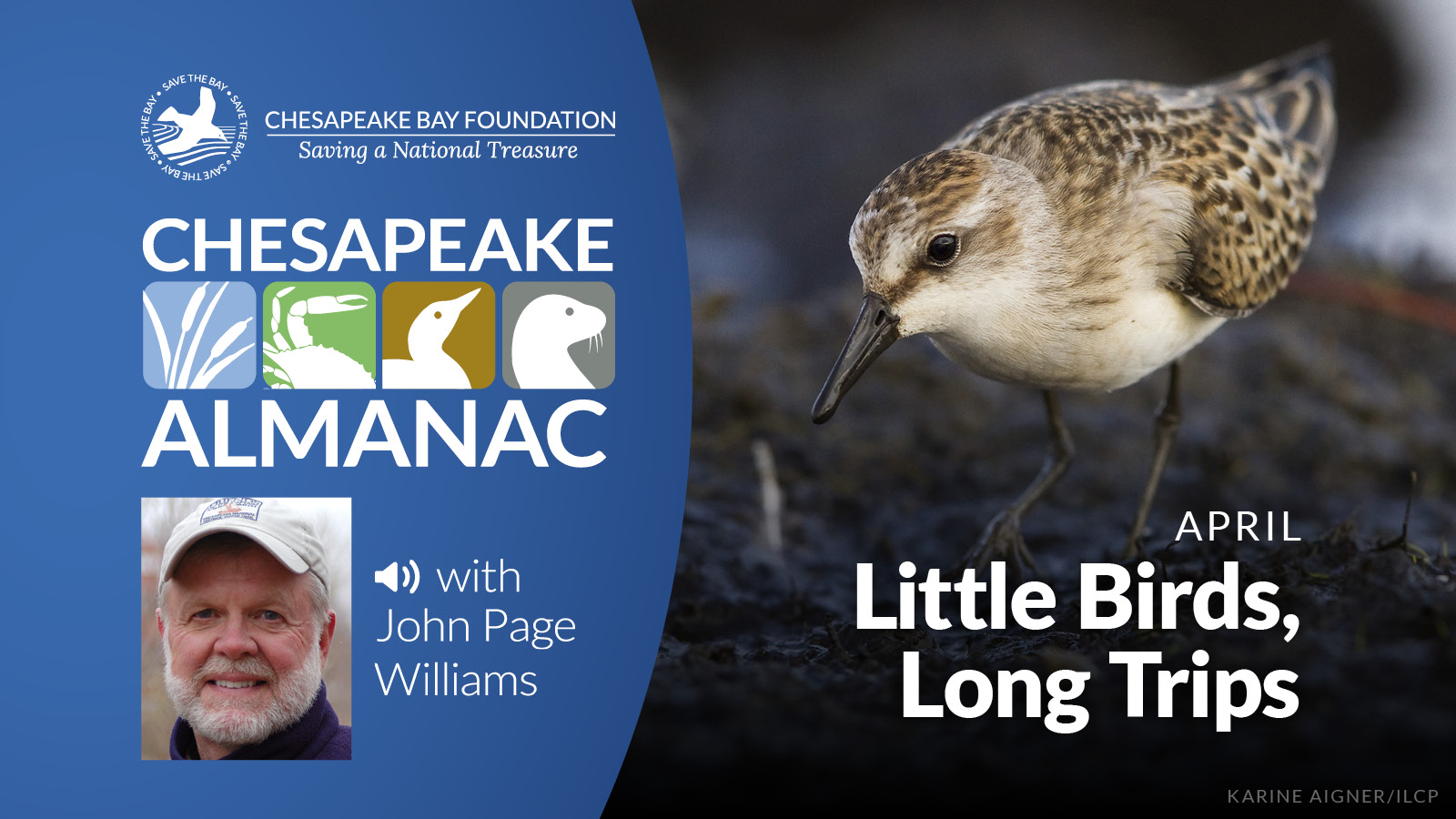
Chesapeake Almanac Podcast
Episode 5: April: Little Birds, Long Trips
Copyright © John Page Williams Jr. All rights reserved.
This is John Page Williams with another reading from Chesapeake Almanac. The title is "Little Birds, Long Trips" and the month is April.
It's Monday, a sunny April day on the Gunpowder just above Joppatown on the western shore north of Baltimore. The canoe glides around a bend, and a small brown-gray bird takes off quietly from a fallen sycamore at the water's edge. It beats its wing several times and then glides. The wings are brown, with double white stripes along the tailing edges. Its white breast is sprinkled with brown dots. The bird, lighting on another log, begins to bob its tail up and down. That's the giveaway. It's a spotted sandpiper (Actitis macularia) and the bobbing tail is a distinctive field mark, easily observed at a distance.
A day later: Tuesday in the Patuxent wild rice marshes. On the old steam barge wreck just below Selby's Landing, there is a small brown-gray bird. As the canoe approaches, it gets up and flies to the duck blind stake at the mouth of Mattaponi Creek. Its tail bobs up and down.
Wednesday on Occupacia Creek off the Rappahannock between Tappahannock and Port Royal: a small brown-gray bird stands, bobbing its tail, on the trunk of an oak tree that has fallen down one of the steep banks. As the canoe approaches, it flies. Thursday in the Big Salt Marsh at Poquoson, a few miles down the bay from the mouth of the York. The tide is out. At the head of a cove, a small brown-gray bird walks over the mud, its bill probing and its tail bobbing.
During the latter part of April, it's possible to go to a different part of the Chesapeake system every day for a couple of weeks and see spotted sandpipers. There are a lot of them migrating through now, but they always turn up by ones and twos, not by large flocks. It is as though a thin veil of birds were being drawn slowly across the Bay country. While most animals gather together in migration, the spotted sandpipers spread themselves out, with a few birds in every nook and cranny of the Chesapeake system.
The birds stay for a short time, feeding on insects, worms, crustaceans, and other invertebrates on the mud flats and marsh banks as they warm in the sun. Then they move on. They're on the way from wintering grounds in the southern United States and Central America to breeding grounds as far north as the Ungava Peninsula on Hudson Bay. They are unobtrusive but sure trademarks of the season.
Their larger relatives, the greater yellowlegs (Totanus melanoleucus), are moving through at the same time. These birds are more conspicuous. Congregating in small flocks of six to twelve, they allow observers to come close to them, and they give clear, whistling calls of three to five notes as they take off to fly. Greater yellowlegs are relatively large shorebirds, 15 inches long in body length, Wing spread about 26 inches. They have brown backs, white rumps and tails, and, of course bright yellow legs. They too are feeding on new life developing in the warm mud of the April marshes. At this time of year, they are most commonly found poking through the stubble of the upriver wild rice marshes.
The yellowlegs travel even greater distances than the spotted sandpiper. They are headed to the North Country tundra and muskeg, spreading themselves across Hudson Bay and all the way west to British Columbia. Some have wintered in the southern United States, but most have come from further south. A few have flown all the way from Patagonia, at the southern tip of South America--quite a trip for a small bird. For them, the Chesapeake's rivers and marshes are good stopover areas for feeding and resting. By mid-May, most will have left the Chesapeake for their breeding grounds.
In the wooded swamps at the heads of rivers and creeks, another bird will be arriving toward the end of the month. This is the beautiful prothonotary warbler (Prothonotaria citrea), bright yellow-range with blue-gray wings. As the swamps turn green, the prothonotaries add splashes of color.
The birds nest in holes in trees anywhere from water level to 25 feet up. Occasionally, a nest even turns up in a floating log. Their eggs are also beautiful, creamy white with deep red, lavender, and purple spots.
Most of the Bay's rivers have these warblers around the headwaters. Cypress rivers like the Chickahominy, Dragon Run at the head of the Piankatank, and the Pocomoke are particularly favored areas, but the ash and maple swamps on rivers like the Pamunkey, Mattaponi, Rappahannock, Patuxent, Choptank, and Nanticoke hold some too.
These are small birds, length five inches, wing spread nine inches, and they also have traveled a long way. They breed and summer through the Midwest and along the East Coast, but they have come all the way from Mexico, Nicaragua, Colombia, and Venezuela. In migration, many of them fly straight across the Gulf of Mexico from Yucatan to the United States. They're fat when they start and lean when they finish.
April is a turning point in the almanac of the Bay country, and indeed in the Western Hemisphere, so the flow of life through here is heavy. It's remarkable how many different birds make different uses of the Chesapeake system at this season.
For more happenings around the Bay in April see our other Chesapeake Almanac podcasts and read our blog posts "Homebound Birding" and "Springtime Silver in the Rivers in April."
Subscribe to this podcast at https://chesapeake-almanac.captivate.fm/listen


